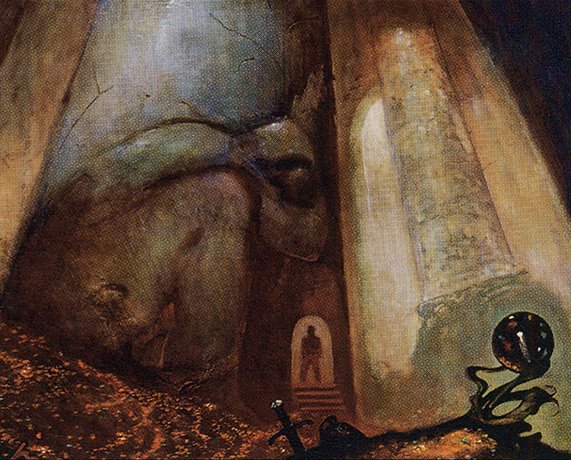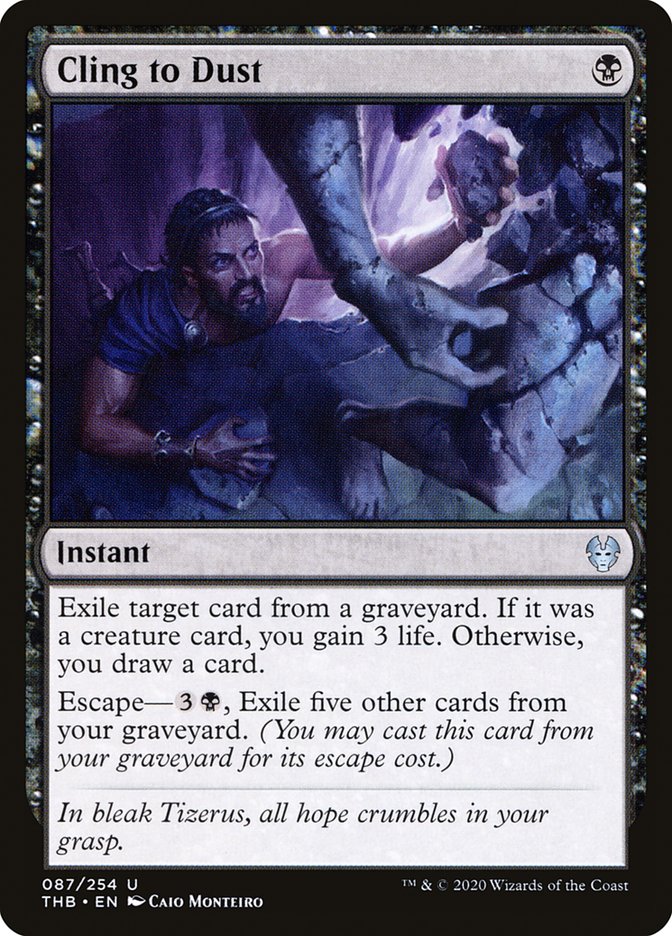Cling to Dust MTG Card
| Mana cost | |
| Converted mana cost | 1 |
| Rarity | Uncommon |
| Type | Instant |
| Abilities | Escape |
| Released | 2020-01-24 |
| Set symbol | |
| Set name | Theros Beyond Death |
| Set code | THB |
| Number | 87 |
| Frame | 2015 |
| Layout | Normal |
| Border | Black |
| Illustred by | Caio Monteiro |
Text of card
Exile target card from a graveyard. If it was a creature card, you gain 3 life. Otherwise, you draw a card. Escape—, Exile five other cards from your graveyard. (You may cast this card from your graveyard for its escape cost.)
In bleak Tizerus, all hope crumbles in your grasp.
Cards like Cling to Dust
Cling to Dust is an interesting utility card found in MTG that offers flexibility and a repeated effect in certain decks. In terms of functionality, it closely mirrors cards like Tormod’s Crypt for its graveyard removal ability. However, Cling to Dust provides an extra layer of value by granting card draw and life gain. Unlike Tormod’s Crypt, which exiles a graveyard in its entirety without additional benefits, Cling to Dust can be used multiple times thanks to its Escape mechanic, even if it targets single cards at a time.
Another card worth considering in this comparison is Soul-Guide Lantern. While both cards deal with graveyard interaction, Soul-Guide Lantern offers one-time graveyard hate along with the potential for card draw. It lacks the recurrable aspect of Cling to Dust but compensates with a wider impact on the game state. Meanwhile, Nihil Spellbomb poses a similar comparison, capable of exiling a player’s graveyard while replacing itself in your hand, but it doesn’t provide the incremental life advantage that Cling to Dust does.
Evaluating Cling to Dust in the larger context of MTG, it’s apparent that its ability to disrupt opponents’ graveyards while sustaining the player’s resources over several turns carves out a unique role for it in many strategies.
Decks using this card
MTG decks using Cling to Dust. Dig deeper into the strategy of decks, sideboard cards, list ideas and export to play in ARENA or MOL.
| # | Name | Format | Archetype | Event |
|---|---|---|---|---|
 | Mono-Black Coffers | Modern | Mono-Black Coffers | Modern Challenge 64 2024-05-20 |
 | Mono-Black Scam | Modern | Mono-Black Scam | Modern Challenge 64 2024-05-20 |
 | Dimir Control | Pioneer | Dimir Control | Pioneer League 2024-05-22 |
 | UB | Pioneer | Pioneer Challenge 32 2024-05-20 | |
 | Mono-Black Discard | Pioneer | Mono-Black Discard | Pioneer Challenge 32 2024-05-20 |
Card Pros
Card Advantage: Cling to Dust offers the potential to incrementally increase your hand resources. By exiling a card from a graveyard, you draw a card, subtly tipping the scales of resource balance in your favor.
Resource Acceleration: While not directly boosting mana, Cling to Dust can provide an indirect form of acceleration. By bringing back the spell through escape, you effectively reuse the card, circumventing the one-time use limitation of many spells.
Instant Speed: The ability to cast Cling to Dust at instant speed means it can be seamlessly woven into your strategy, allowing for responsive plays against opponents. Whether it’s disrupting graveyard strategies or sneakily refilling your hand, the versatility of its timing can prove to be a game-changer.
Card Cons
Discard Requirement: Cling to Dust necessitates exiling a card from a graveyard to activate its escape mechanic. This can be a tactical disadvantage as it relies on having sufficient cards in your own graveyard, potentially reducing the options for later plays.
Specific Mana Cost: With a mana cost requiring one black, this card aligns strictly with black mana decks, thereby limiting its flexibility in multicolor deck strategies where black mana might be less available.
Comparatively High Mana Cost: Activating the escape cost for Cling to Dust asks for three generic and one black mana along with five other cards to exile from your graveyard, which can be a considerably high price for its one-time card draw and life gain effect, particularly in the fast-paced formats where efficiency is key.
Reasons to Include Cling to Dust in Your Collection
Versatility: Cling to Dust is an efficient card that provides both incidental graveyard interaction and life gain, offering utility in various deck types. Its ability to exile cards from graveyards can disrupt opponent strategies while also drawing you a card, making it versatile for decks concerned with card advantage.
Combo Potential: This card’s escape mechanism allows for repeated use from the graveyard, offering synergy with strategies that fill the graveyard for value or recursion. Paired with cards that profit from casting spells multiple times, Cling to Dust can become an essential piece in recurring combo methods.
Meta-Relevance: Given its low cost and ability to interact with opposing graveyards, Cling to Dust can be a relevant sideboard option against decks dependent on graveyard strategies or to mitigate life loss against aggressive decks, adapting well to shifting metagame demands.
How to beat
Cling to Dust from MTG is an intriguing card that offers both utility and flexibility. Used primarily in graveyard-based strategies, it allows a player to exile target card from a graveyard. If a creature card was exiled this way, you gain 3 life. Otherwise, you draw a card. Cling to Dust can be particularly frustrating to play against when you’re relying on graveyard synergy or crucial spells you’d like to recur.
To effectively counter Cling to Dust, it’s key to minimize its impact. Tactics such as graveyard shuffling, where you regularly return cards from your graveyard to your library, can help. This ensures that Cling to Dust has fewer targets and may end up being a less efficient play for your opponent. Additionally, running cards that grant graveyard protection or that can exile your own cards in response can negate the advantages Cling to Dust offers. Always be mindful of your graveyard’s contents and be ready to adapt if Cling to Dust is in your opponent’s deck.
Understanding its strategic use and timing your responses effectively are crucial to overcoming this versatile spell, allowing you to maintain the upper hand by protecting your graveyard resources or by forcing less optimal plays from your adversary.
BurnMana Recommendations
Exploring MTG’s intricacies can be as rewarding as it is challenging. With a nuanced card like Cling to Dust, opportunistic plays and graveyard manipulation enrich your tactical depth. Recognizing its potential as a flexible tool is key, whether you’re keen on disrupting graveyard-based tactics or stretching your card advantage. Consider its escape ability as a strategic asset in your arsenal. If you’re eager to optimize your deck-building and gameplay, delve into analyses of cards like Cling to Dust that might tip the scales in your favor. For deeper insights and pro tips on card utility and deck synergy, keep checking back with us. Let’s boost your mastery and edge over the competition together.
Where to buy
If you're looking to purchase Cling to Dust MTG card by a specific set like Theros Beyond Death, there are several reliable options to consider. One of the primary sources is your local game store, where you can often find booster packs, individual cards, and preconstructed decks from current and some past sets. They often offer the added benefit of a community where you can trade with other players.
For a broader inventory, particularly of older sets, online marketplaces like TCGPlayer, Card Kingdom and Card Market offer extensive selections and allow you to search for cards from specific sets. Larger e-commerce platforms like eBay and Amazon also have listings from various sellers, which can be a good place to look for sealed product and rare finds.
Additionally, Magic’s official site often has a store locator and retailer lists for finding Wizards of the Coast licensed products. Remember to check for authenticity and the condition of the cards when purchasing, especially from individual sellers on larger marketplaces.
Below is a list of some store websites where you can buy the Cling to Dust and other MTG cards:
 BUY NOW
BUY NOW BurnMana is an official partner of TCGPlayer
- eBay
- Card Kingdom
- Card Market
- Star City Games
- CoolStuffInc
- MTG Mint Card
- Hareruya
- Troll and Toad
- ABU Games
- Card Hoarder Magic Online
- MTGO Traders Magic Online
See MTG Products
Legalities
Magic the Gathering formats where Cling to Dust has restrictions
| Format | Legality |
|---|---|
| Historicbrawl | Legal |
| Commander | Legal |
| Historic | Legal |
| Legacy | Legal |
| Modern | Legal |
| Oathbreaker | Legal |
| Vintage | Legal |
| Duel | Legal |
| Explorer | Legal |
| Gladiator | Legal |
| Pioneer | Legal |
| Timeless | Legal |
Rules and information
The reference guide for Magic: The Gathering Cling to Dust card rulings provides official rulings, any errata issued, as well as a record of all the functional modifications that have occurred.
| Date | Text |
|---|---|
| 2020-01-24 | After an escaped spell resolves, it returns to its owner’s graveyard if it’s not a permanent spell. If it is a permanent spell, it enters the battlefield and will return to its owner’s graveyard if it dies later. Perhaps it will escape again—good underworld security is so hard to come by these days. |
| 2020-01-24 | Cling to Dust can target one of the five cards you’ll exile to pay its escape cost. In this case, the spell won’t resolve. |
| 2020-01-24 | Escape’s permission doesn’t change when you may cast the spell from your graveyard. |
| 2020-01-24 | If a card has multiple abilities giving you permission to cast it, such as two escape abilities or an escape ability and a flashback ability, you choose which one to apply. The others have no effect. |
| 2020-01-24 | If a card with escape is put into your graveyard during your turn, you’ll be able to cast it right away if it’s legal to do so, before an opponent can take any actions. |
| 2020-01-24 | If the exiled card is a creature card that’s also another card type (such as an enchantment creature), you gain 3 life. You don’t also draw a card. |
| 2020-01-24 | If the target card is an illegal target by the time Cling to Dust tries to resolve, the spell won’t resolve. You won’t gain 3 life or draw a card. |
| 2020-01-24 | If you cast a spell with its escape permission, you can’t choose to apply any other alternative costs or to cast it without paying its mana cost. If it has any additional costs, you must pay those. |
| 2020-01-24 | Once you begin casting a spell with escape, it immediately moves to the stack. Players can’t take any other actions until you’re done casting the spell. |
| 2020-01-24 | To determine the total cost of a spell, start with the mana cost or alternative cost you’re paying (such as an escape cost), add any cost increases, then apply any cost reductions. The mana value of the spell remains unchanged, no matter what the total cost to cast it was and no matter whether an alternative cost was paid. |



